How to make your own Sourdough Starter, using simple ingredients with no special equipment, in just six days, that can be used in our sourdough bread. Video.
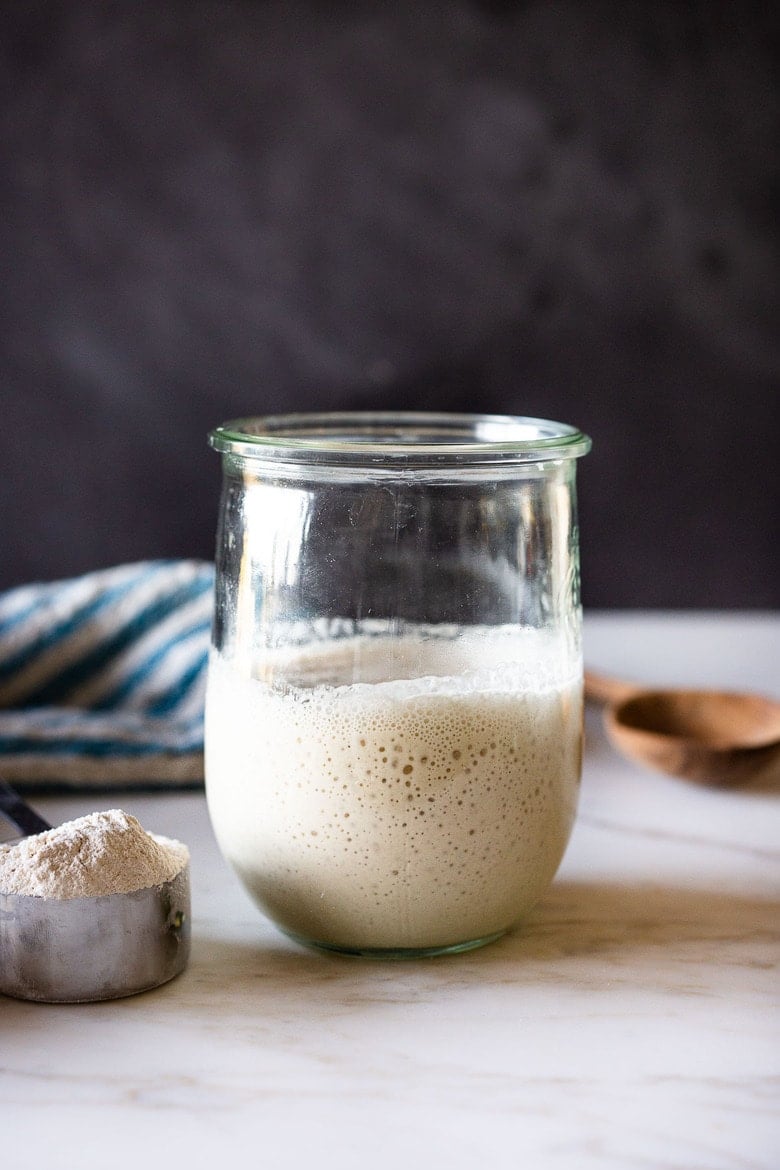
When you understand one thing through and through, you understand everything.~ Shunryu Suzuki
With over 500 five-star reviews and hundreds of success stories, my chef’s perfected sourdough starter guide has everything you need to make your own homemade starter. In just six days, you’ll be baking the most beautiful sourdough loaves!
But first, What is a starter?
Sourdough starter is a “wild yeast” made from flour, water, and the natural wild yeast in the air. With a little care and patience, it ferments, and when strong and active, just a little bit of starter replaces commercial yeast and makes your bread rise, while transforming the gluten in the bread into something more easily digestible. Store-bought yeast is not needed!
How to Make Sourdough Starter | 20-Min Video
***Don’t see the video? Allow 15-20 seconds to load it right here!*** (Still don’t see it? Check that your ad blocker is turned off; use Chrome for the best experience.)
Fast forward to Specific Day by video time (using scroll bar underneath video)
- Day 1 Morning: :23
- Day 2 Morning: 4:10
- Day 3 Morning: 7:00
- Day 3 Evening: 9:12
- Day 4 Morning: 11:50
- Day 4 Evening: 13:37
- Day 5 Morning: 14:45
- Day 6 Evening: 16:50
- Day 6 Morning: 18:12
- Day 6 Evening: 20:10
Sourdough Starter Recipe Ingredients
- Jar – A wide-mouth quart jar or a Weck’s 1-liter tulip jar.
- Flour – 5 lb bag of organic bread flour (plus 1 cup organic whole grain flour )
- Water – filtered water, tap water, or mineral water (specifically, San Pellegrino, for the correct mineral ratio). Distilled water does not have enough minerals.
- Scale – using a kitchen scale is optional but handy.
- Thermometer – Knowing the temp of the starter using a thermometer is optional but handy!
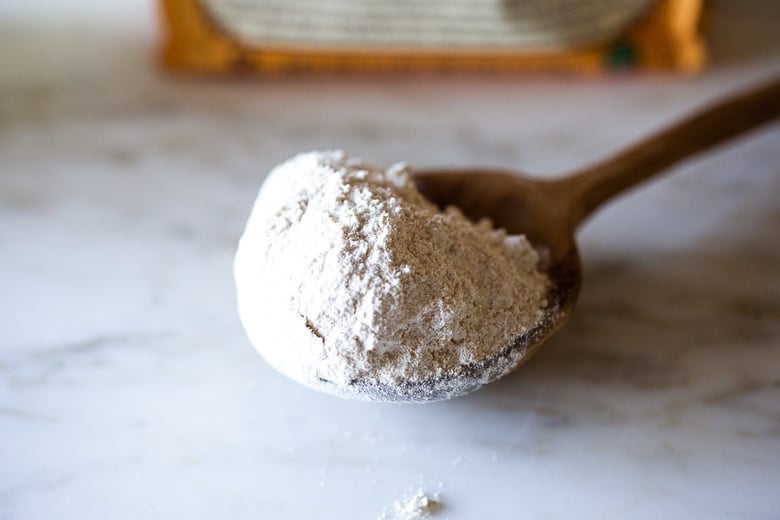
Understanding starter
- Think of sourdough starter as yeast. Only in this case, instead of buying a packet of yeast from the store, you are making your own living “wild yeast” by fermenting flour and water. Once it’s bubbly and happy, it is very much ike a very low-maintenance pet.
- You must feed it (stir in a mixture of flour and water) once a week to keep it active and strong. You know it’s happy when it bubbles. 😉 And YES, you can even name it.
- Some people believe that bread made with sourdough starter is actually better for you than bread made with yeast. Here and Here are a few articles to get you started on your own research. While I’m not sure if this is scientifically proven, I do know that bread made with sourdough starter, tastes infinitely better, feels easier to digest, and has more complexity and better texture, than bread made with commercial yeast. So if you are a bread lover- this is absolutely the way to go, as far as the quality of your finished bread.
How to Make Sourdough Starter
*See the recipe card for detailed instructions.
This recipe for Sourdough Starter takes 6 days (or up to 12 days if it is very cold where you live). For a primer, watch the 20-minute Sourdough Video above!
Day 1: Staring in the morning or at night, using a wide-mouth quart jar, tulip jar, or Crock or Glass Measuring Cup , mix 1 cup whole grain flour (120 grams) with 1/2 cup filtered water (120 grams) using a fork (or chopstick) making sure you’ve incorporated all the dry flour.
Place the lid lightly on top (using the Weck jar lid is really handy here) or a wet towel to keep moisture in, or plastic wrap- and let sit at room temperature (70-ish degrees) on the kitchen counter for 24-48 hours. If you are unsure how warm it is, use a kitchen thermometer and check it a few hours later. See notes for TEMPERATURE.
TIP #1: For your first measurement, weigh the flour using a kitchen scale so you can get an idea of how the mixture should feel. Do not weigh the measuring cup! It should be like a thick paste, like peanut butter. If you need to add a little more water to incorporate the flour, that is OK too!
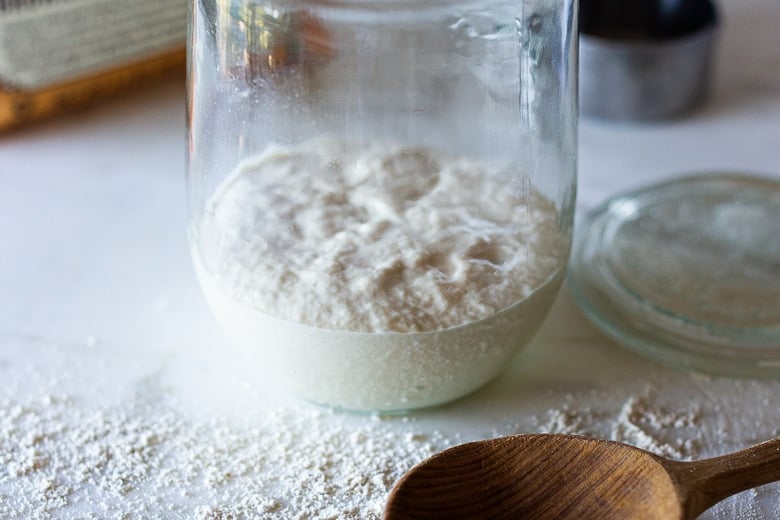
Day 2: After the first 24 hours, there may or may not be a bit of bubbling. Let the mixture rest until you see activity (bubbles or rising) sometimes this takes 36 hours or even 48 hours if very cold. When you see active bubbling, discard all but 1/2 cup of the starter (4 ounces).
To the remaining ½ cup of starter, stir in 1/2 cup water (120 grams), and mix well with a fork. Add 1 cup of organic bread flour (120 grams)spooned and leveled. Stir until combined. Again, it should feel like a thick paste. If overly dry, feel free to add a bit more water. Cover again and allow the mixture to sit at room temperature for another 24 hours.
Day 3: After 24 hours, hopefully, you will see some bubbling or rising and if not, let it go a bit longer until you see activity. Be patient.
Depending on how warm your house is and how active your starter, you may need to begin feeding more often or move to two feedings a day, in the morning and at night. If it is cold, one feeding a day may be enough.
TIP #2: Only feed the starter after it has peaked or looks hungry. See the “3 Signs of Hunger” below. Feeding it when it is “not hungry” will basically dilute all the growing yeast and make it lethargic. Better to underfeed than overfeed.
The 3 Signs of hunger
The photo below was taken after the starter was fed, and after it peaked (reached its highest), and now is sliding down. It is now “hungry” again. See the downward slide marks on the jar? Pay attention – your starter is telling you it is hungry.
- Look for “slide marks” (be sure to use a clean jar so you can see these clearly).
- Liquid at the top of the starter.
- Thin and runny. The starter is liquidy enough to pour out of the jar (when at room temp).

This might be 12 hours, it might be 14, it might be 18, or 24, depending on the temp in your house. In very warm climates, it may only be 6-8 hours. In winter, this may take 36 hours. It is better to underfeed rather than overfeed here.
For each feeding, discard all but 1/2 cup of the starter (keeping roughly ½-cup of starter in the jar). Add 1/2 cup water and 1 cup Bread Flour (spooned and leveled). Mix well, cover, and let this rest at room temperature for 12-24 hours or until the starter looks “hungry” again before repeating.
Day 4: Feed 1-2 times, discarding all but 1/2 cup of starter each time. Feed 1 cup bread flour, 1/2 cup water.
TIP #3: It is typical on day 4 for the starter to slow down and stall a bit. This is OK. Just keep going, be patient and look for the hunger signs, and only feed when clearly hungry. Hopefully, you’ll begin to see some rising and falling. It’s helpful to put the starter in a clean jar each day and mark the beginning level (with a sharpie, string or rubber band) so you can easily see this.
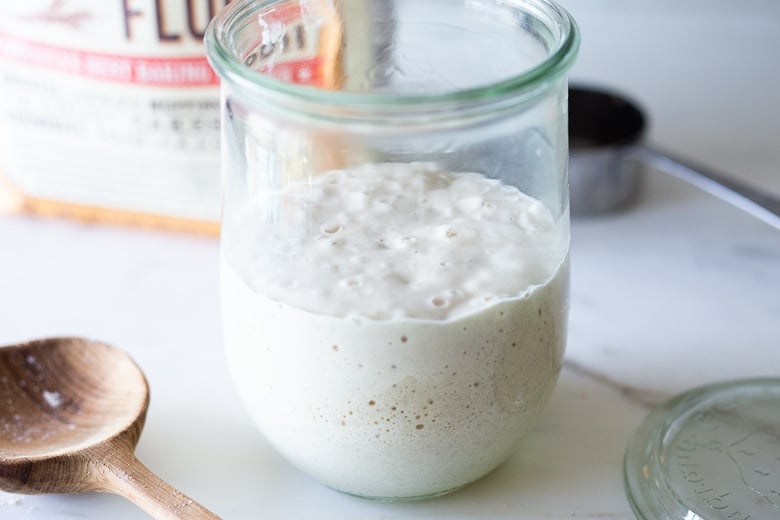
Above, you’ll see it peaking, and below, you’ll see it deflating and getting “hungry.” There may not be too much difference in the beginning, so look closely.
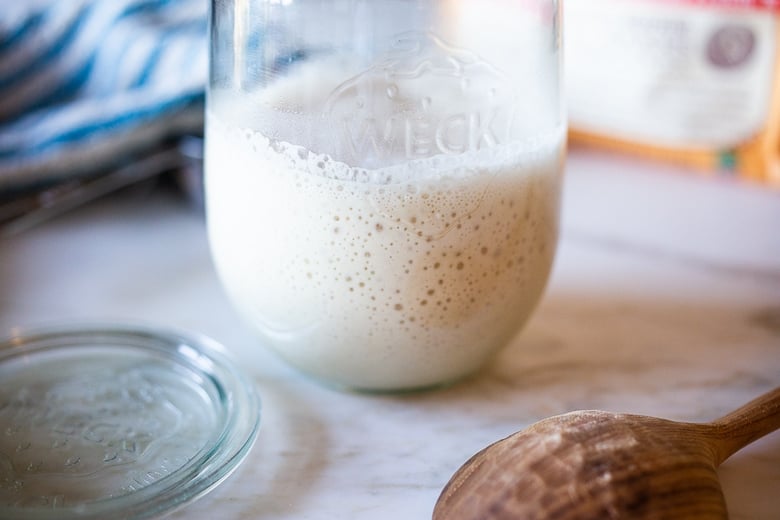
Understand that your starter has a schedule of its own; it is a living thing, so watch it and pay attention.
If your starter is not rising and falling, look at its consistency. As it metabolizes the flour and gets hungry, it will get runny and liquidy, like to the point where you can pour it right out of the jar. If it is still thick like paste, it’s not done metabolizing (eating)the flour.
Day 5: Feed again, 1-2 times, discarding all but a 1/2 cup the starter each time. Adding 1 cup bread flour and 1/2 cup lukewarm water. The starter should look visibly active, bubbling, rising, hopefully, close to doubling in size.
Repeat day 5 until the starter is rising and falling predictably and is close to doubling in size within 6-8 hours.
TIP #4: If your starter is not rising but there is evidence of hunger (liquidy or liquid at the top) try 3 things: substitute 1/4 cup whole grain flour (add to ¾ cup white bread flour) on your next feeding. Try using mineral water like San Pellegrino instead of water. Stir the starter a few times after feeding to allow more wild yeast from the kithcen to get inside.
DAY 6 Morning: Baking day! Give it one last feeding in the morning: this time discard all but a 1/3 cup. (The reason we are changing this to 1/3 cup is to feed it a little bit more.) Add 1 cup flour (120 grams) and 1/2 cup water, stir, and place it in a clean jar so you can see the action clearly. You can use a sharpie or place a rubber band around the jar to mark the beginning level. The starter should hopefully double in volume within 6-8 hours of feeding.
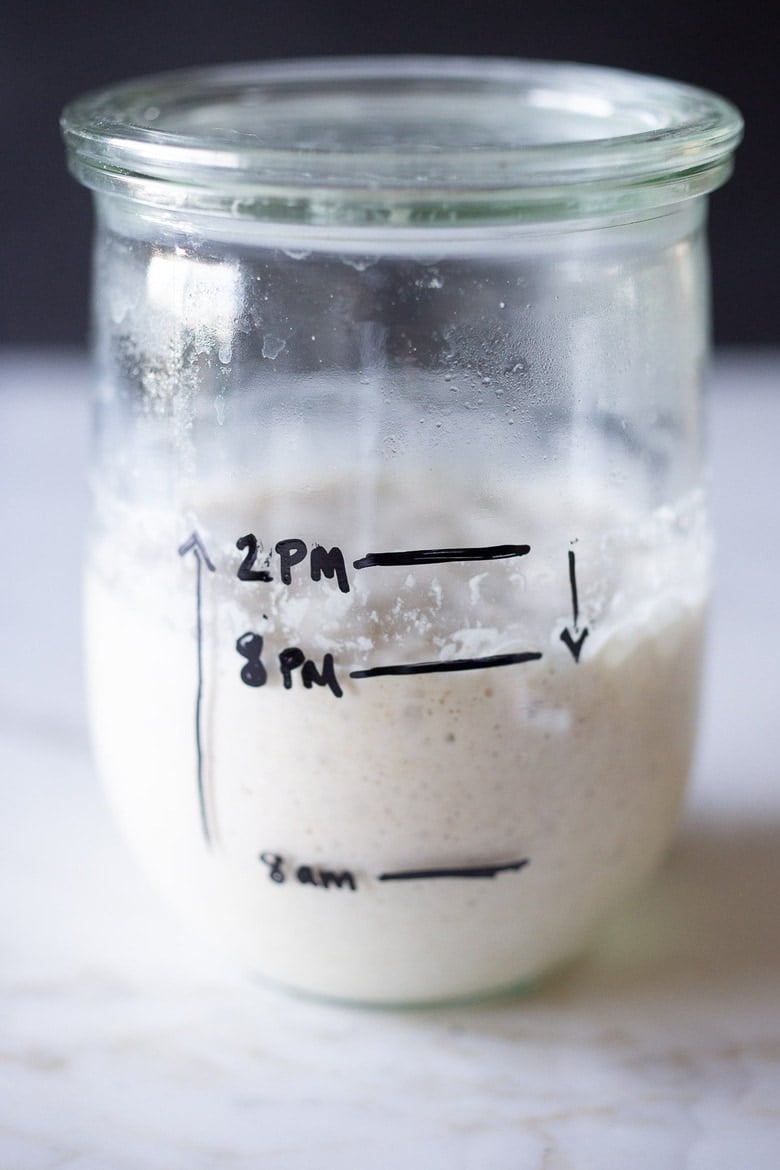
In the photo above, on the 6th day, the starter was fed at 8 am, it peaked around 2 pm, then it started deflating, and by 8 pm, it was “hungry” again. See those downward “slide” marks on the jar?
DO THE FLOAT TEST: When the starter is at its peak, or just after, place a teaspoon of starter (just from the top, don’t stir it down) in a glass full of water; it should hopefully float. If it floats, success!!! Congrats. You can now make our sourdough bread…tonight!
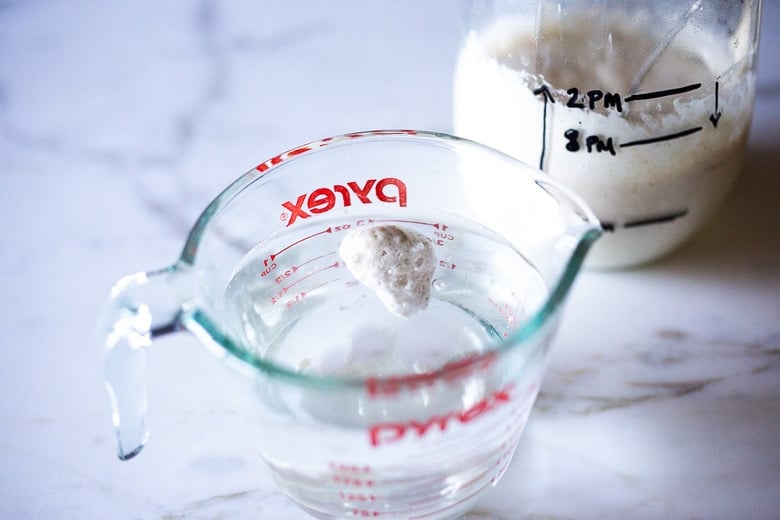
TIP #5: When baking bread always use hungry starter that has already peaked!
STARTER DOES NOT FLOAT? If it doubles in size but does not float, you can still try baking a loaf if it doubles within 6-8 hours of feeding it.
At this point, if your starter does not double in size within 6-8 hours of feeding, don’t give up! Often, it just takes longer, especially during the winter months. Continue feeding one to two times a day until you see a consistent, predictable rise and fall.
Read the troubleshooting section. If you need to take a break, put it in the fridge and try it again up to a week later. Don’t toss it!
Day 6 Evening: Let’s Bake! Use 1/3 cup starter to make this sourdough bread recipe and place the remaining starter (or if not making bread, place all of it) in the refrigerator, and feed it at least once a week, reserving ½ cup starter, before feeding it the usual 1 cup bread flour, 1/2 cup water.
TROUBLESHOOTING Starter
- SMELL: Starter should smell sweet, tangy, earthy, like a wet horse – not “bad”. If it really smells foul or unpleasant, you may have used an unclean jar, unclean utensil, or somehow introduced other bad bacteria. I would start over.
- NO ACTION: On day 4-5 it is typically for it to slow down. If your starter is not rising at all but there is evidence of hunger (liquid at the top, or bubbles) try 3 things. First substitute 1/4 cup whole grain flour (add to ¾ cup white bread flour) on your next feeding. If no rise, then try using mineral water, specifically San Pellegrino instead of water. San Pelligrino specifically has the right mineral ratio, I have great luck with it. Others not so much! Also try stirring the starter a couple of hours after feeding, a couple of times throughout the day to allow wild yeast from the room to get in there. Lastly, you could try pineapple juice instead of water.
- FLOUR: Try to use fresh milled whole grain flour to start, then organic BREAD FLOUR. The more wild yeast in the flour, the better your starter will do- so smaller brands like Bob’s Red Mill seem to do better than bigger conventional brands that have been overly processed. It is totally OK to mix flours and to switch them up- this adds different kinds of wild yeast- a good thing!
- DO NOT overfeed. For example, maybe feeding 2 x day at 12-hour intervals is too often. You want to feed after the starter has peaked, then deflated (see photo above- you’ll see some slide marks on the jar) and this tells you that it is hungry. If you feed the starter before it has had a chance to metabolize (or eat) all the flour (before peaking) and then you discard part of it, and feed it again, you are actually diluting all that amazing bacteria, weakening your starter. So it’s all about watching your starter in your home. If you are not seeing rising and falling, but notice the starter just gets liquidy, this too is a sign of “hunger”. Or if it gets runny enough to pour out of the jar, another sign it is hungry. There are lots of variables here. Just be patient, pay attention and watch. This is a living thing- it doesn’t care about time schedules and recipes or what it “should” do. It will “eat” when it is “hungry” and sometimes it likes to eat slowly. 😉
- TIME: It may take longer than 6 days in colder environments. Use a kitchen thermometer and take its temp. Is it over 65F? Find a place where it can be warm. In the oven with the light on, or in an upper cupboard ( heat rises). Sometimes it takes 12-14 days! Be patient, keep going. If it is doing absolutely nothing, leave it out on the counter for 24-48 hours and see what happens. If you run out of flour or need a break, don’t just toss it, put it in the fridge and see if you can get it going a few days later.
- ACIDITY: If you still can’t get that starter going, some people recommend subbing pineapple juice for the water for one feeding- raising the acidity level. My good friend just tried this and it got hers going.
- LIQUID: If you see any liquid at the top of your starter, it means your starter is hungry. So, yes it’s still alive which is a good thing! You can stir the liquid in, or pour the liquid out, either way, but feed it. This is a sign that you may need to feed it more often.
- MOLD: if you see any discoloring or mold on the surface, starter was probably contaminated. If it is only on the surface, it is probably ok to save. Scrape it off, save 1/2 cup of the underneath starter, and keep going, using a clean jar. Feed, smell, use your best judgment.
- FLOAT TEST: Try testing when your starter is peaking. Take a spoonful from the top without stirring it down. If your starter is rising and falling consistently, but not passing the float test and it has been over 8-10 days- just try baking a loaf. People are having luck with good loaves without passing the float test. It may be the flour…
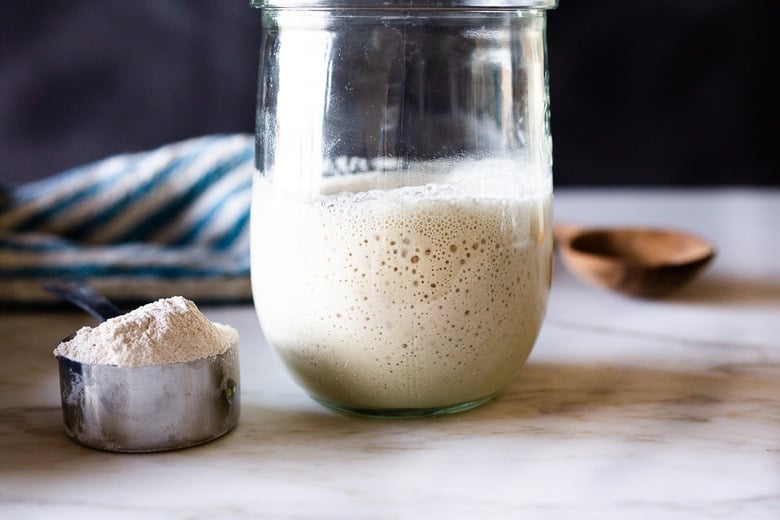
How to Maintain Your Starter
- REFRIGERATE & FEED AT LEAST ONCE A WEEK: Pick a scheduled day and try to stick with it, always reserving 1/2 cup and feeding it 1 cup flour and 1/2 cup water. Discard the remaining, give it away, or keep the discard in a separate container for sourdough pancakes, sourdough buns, banana bread, biscuits, etc. I usually don’t feed the discard unless I give it away.
- If you forget to feed it one week, it is most likely OK; feed it 1-2 times a day for 1-3 days in a row to revive it (keeping it out on the counter) until bubbly and active and doubles within 6 hours. I’ve left my starter for a month on vacation (in the fridge) without feeding and simply revived it by feeding it 3 days in a row, 1-2 x day. It’s surprisingly hard to kill. You can also freeze it for more extended storage.
- This batch will allow you to bake 2 loaves of bread per week with enough left to feed for the next week. If you want to bake more often, you can keep it out and feed it 1-2 x daily. Or if baking every few days, you can pull it out of the fridge, feed it 10 hours before using, leaving it out, use what you need while it is peaking (or slightly after), then put it back in the fridge that evening. Do the same thing a few days later when ready to use again. So this would be feeding 2-3 times a week, best if baking 4-5 times a week.
The best time to use sourdough starter is just after it peaks or on its way down when you know it is hungry.
Sourdough Bread Starter FAQs
Yes. While you are building your starter, during the first week, it is the simplest, easiest, fastest, and most economical way to create a healthy starter. (Or save it separately -in the fridge- and use it in Pancakes, Waffles, Buns, or Biscuits. ) This is because you always have to feed it two times its volume in flour. For example-if you kept all the 1 1/2 cups of starter, you would have to feed it 3 cups of flour (instead of keeping just a 1/2 cup and only feeding it ONE cup). Discarding will shorten the fermentation process, require less flour in the long run, and create a stronger starter. Once your starter is “established” after the first week- then you can give it away to friends, use it in pizza dough, pancakes, etc) or give it to a friend.
How to use your Sourdough Starter
- See all our Sourdough Recipes!
- Sourdough Scones
- Sourdough Crackers
- Sourdough Biscuits
- Sourdough Buns
- Sourdough Tortillas!
- Vegan Banana Bread
- Overnight Sourdough Waffles
More from Feasting At Home
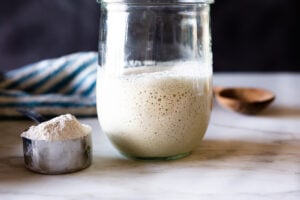
Simple Sourdough Starter
- Prep Time: 30
- Cook Time: 6 days
- Total Time: 144 hours 30 minutes
- Yield: 1 ½ cups
- Category: sourdough, fermented, cultured, bread, baking,
- Method: fermented
- Cuisine: bread
- Diet: Vegan
Description
How to make your own Sourdough Starter (see the step-by-step video in post) using simple ingredients with no special equipment, in 6 days, that can be used in sourdough bread. Sourdough Starter is a wild yeast, made from fermenting flour and water.
Ingredients
- 120 grams whole grain flour (whole wheat flour, rye flour, or freshly milled flour) 1 cup, fluffed, spooned and leveled
- Organic White Bread Flour (5-10 lb bag ) I like Shepherd’s Grain or Bob’s Red Mill.
- 120 grams Water per feeding (1/2 cup water)
Instructions
-
- Day 1: Starting in the morning or at night, using a wide-mouth quart jar or Crock or Glass Measuring Cup mix 1 cup whole grain flour (120 grams) with 1/2 cup (120 grams) filtered water using a fork making sure you’ve incorporated all the dry flour. For your first measuring – it is a good idea to weigh the flour, using a kitchen scale so you get an idea of how thick it should feel. It should be like a thick paste. Thick like peanut butter. If you need to add a little more water to incorporate the flour, that is OK, but be precise with the flour. Place the lid on top (using the Weck jar is really handy here) or a damp towel to keep moisture in, or plastic wrap- and let sit at room temperature (70-80 degrees) on the kitchen counter for 24-48 hours, or until you see some bubbling. If you are not sure how warm it is, use a kitchen thermometer and check it a few hours later. See notes for TEMPERATURE.
- Day 2: After the first 24 hours, you may or may not see a bit of bubbling. I prefer to let this rest until I see a tiny bit of activity (bubbles) and sometimes this takes 36 or up to 48 hours. So start “day 2”, when you see a little bit of bubbing. Discard all but 1/2 cup (136 grams) of the starter. (See notes for discard). Add to the remainder, 1 cup of white bread flour, (120 grams), spooned and leveled, and 1/2 cup filtered water (120 grams), mixing well with a fork. Place the lid on loosely again and allow the mixture to sit at room temperature (70-80F) for another 24 hours.
- Day 3: By the third day, you should definitely see some bubbling- and if not, let it go a bit longer. Depending on how warm your house is and how active your starter, you may need to begin feeding more often, or even move to two feedings a day roughly 12 hours apart, like in the morning and at night. In a nutshell, you want to feed the starter only after it has peaked (metabolized all the flour from the last feeding) and has started sinking down or gets liquidy- this is when it is hungry! This might be 12 hours, it might be 14, it might be 18, or 24, depending on the temp in your house. In very warm climates it may only be 8 hours. It is better to underfeed rather than overfeed here. For each feeding, like before, discard all but 1/2 cup of the STARTER (keeping roughly ½-cup of starter in the jar -4 ounces or 136 grams) Add 1 cup Bread Flour (spooned and leveled) and 1/2 cup water to the 1/2 cup starter and let this rest at room temperature for 12-24 hours or until the starter looks “hungry” again before repeating.
- Day 4: Feed 1-2 times, discarding all but 1/2 cup of starter EACH TIME. Feed 1 cup bread flour, 1/2 cup water. Look for the hunger signs. Hopefully, you’ll begin to see some rising and falling. It’s helpful to put the starter in a clean jar and mark the beginning level (with sharpie, string or rubber band) so you can easily see this. ***If for some reason your starter looks like it is still rising at the time of second feeding (at night) and there is no evidence it has fallen or no slide marks, it is still “eating” so skip this feeding and feed first thing in the morning. AGAIN, Feeding it when it is “not hungry” will basically dilute all the growing yeast and make it lethargic. Better to starve than overfeed.
- Day 5: Feed again, 1-2 times, roughly 12 hours apart, or when hungry, discarding all but a 1/2 cup the starter EACH TIME. 1 cup bread flour, 1/2 cup lukewarm water. The starter should look active, bubbling, rising, sliding down, hopefully, close to doubling in size. (If not, repeat this day until starter doubles in size within 8-12 hours of feeding- and read the troubleshooting section.)
- DAY 6: Give it one last feeding. Discard all but a 1/3 cup. Add 1 cup flour ( 120 grams) and 1/2 cup water, and place it in a clean jar so you can see the action clearly. You can use a sharpie or place a rubber band around the jar to mark the beginning level. The starter should hopefully double in volume within 6 hours of feeding. When it peaks, DO THE FLOAT TEST: To test the starter, place a teaspoon of starter (just from the top, while it is peaking, don’t stir it down) in a glass full of water, it should hopefully float. If it does, you can make sourdough bread. Tonight! Let the starter keep resting at room temperature or a few more hours allowing it to fully metabolize the flour, perhaps sinking a little before making your dough. You want to make dough with slightly hungry starter. Place the remaining starter in the fridge and feed it in a week. You’ll have enough stater to make one more sourdough loaf during the week, and still have enough to feed. If you want to wait to make bread until later in the week place starter in the fridge. Be sure to feed it in 7 days. Read maintenance section.
- At this point, if your starter does not double in size don’t give up! Often it just takes longer, sometimes up to two weeks, especially if it’s cold. Continue feeding one-two times a day (only when hungry) for a few more days, until you see a visible rise and fall. Read the troubleshooting section. If you need to take a break, just put it in the fridge and try it again up to a week later. Don’t toss it- if there are bubbles, it is still alive.
- This batch of starter will make two loaves of bread with enough left over to feed for the following week.
Notes
- TEMPERATURE: The colder your home, the longer it will take for the starter to grow and become active (bubbles). Find a warm spot (70-80 degrees) for the best results. On the stovetop, with the light turned on, or on top of the fridge. Or in the oven with the light on. On top of a heating pad (set to low) with a towel in between). You can still make the starter in a colder home, it will just take longer- even up to 2 weeks.
- FLOUR: Always try to start the batch by using organic, freshly milled whole-grain flour (wheat or rye) because it has more wild yeast in it than All-Purpose or white flour and will get it active and growing sooner. You can, of course, continue to use whole grain, but I’ve had the best luck using organic “bread” flour for days 2 through 6. People have made a sourdough starter with All-Purpose flour- but personally, this has never worked for me– there are fewer nutrients and wild yeasts in the flour and results in a very lethargic starter. If it is your only option, try mixing in 2+ tablespoons of whole-grain (wheat or rye) with the AP flour per feeding. Feel free to use different flours or mix different flours together. It is OK to use all-purpose flour if in a pinch, but using it repeatedly will result in sad starter.
- WATER: I usually use tap water -but sometimes the chlorine in tap water can inhibit the growth of your starter. Lukewarm water helps fermentation to start faster. Sterilized bottled water is often overly sterile, and can also inhibit. Mineral water, like Perrier (carbonated is OK) can sometimes work miracles.
- HYDRATION: Hydration refers to the ratio of water to flour in terms of weight. It is a ratio. The starter is typically at 100% hydration- meaning equal parts flour and water, in terms of weight. So if you use 120 grams of water, use 120 grams of flour. This roughly translates to 1 cup of flour and 1/2 cup water. Feel free to weigh instead of measure if you want to be more precise, or want to familiarize yourself with the consistency you are aiming for. If using whole grain flours (which tend to be “thirstier”) and your starter seems very thick, it is totally OK to add more water to thin it a bit. I intentionally keep the hydration a little lower here (a thicker starter) so you can more clearly see the rise and fall “action” in the jar.
- STORING AND FEEDING: When your starter is kept cold, in the fridge, you don’t need to feed it as often- only once a week. Feel free to feed it “cold”, and put it right back in the fridge if you like. If you keep it out on the counter, you’ll likely need to feed it 1-2 x daily (or just watch and feed only when hungry). Cold slows down the fermentation, heat speeds it up.
- USING: When you need to use your starter for baking bread, feed it 10-12 hours before making bread dough, using it after its peak height. For a more “sour” flavored bread, use the starter straight from the fridge, 3-6 days after feeding. The starter gets more sour tasting the longer it goes without feeding. Feeding the starter the same day as making bread will produce a milder sourdough flavor.
Nutrition
- Serving Size: 1 tablespoon
- Calories: 31
- Sugar: 0 g
- Sodium: 0.2 mg
- Fat: 0.1 g
- Saturated Fat: 0 g
- Trans Fat:
- Carbohydrates: 6.2 g
- Fiber: 0.2 g
- Protein: 1 g
- Cholesterol: 0 mg
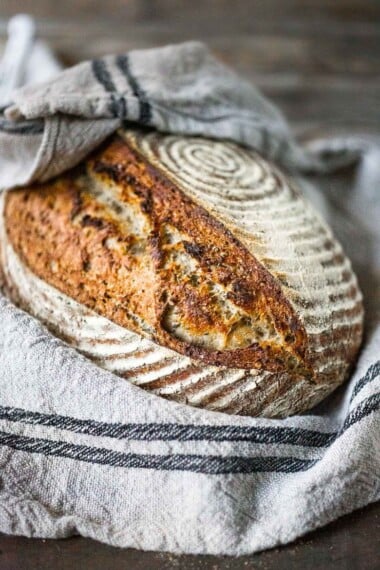

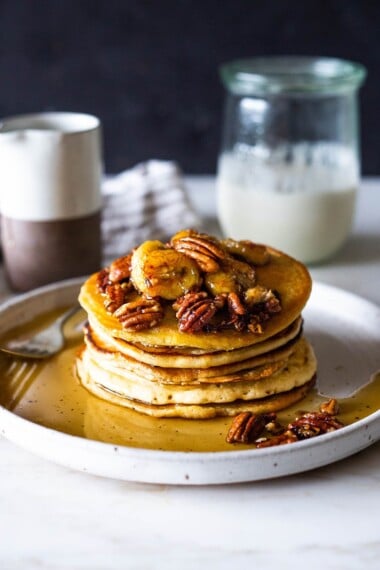
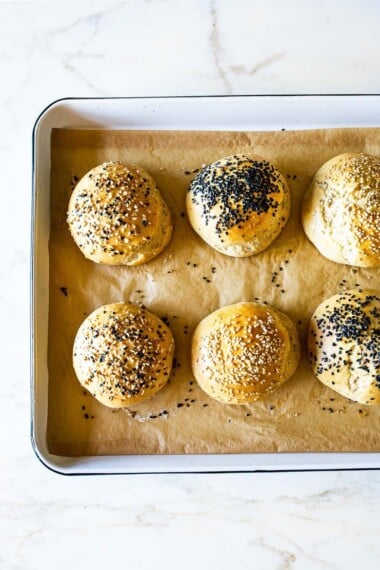







This has been an incredibly helpful and informative resource. I continue coming back to your tips and suggestions as I play around with my new sourdough skills. I’ve made 3 successful loaves now and plan to begin some experimenting. I also tried your banana bread recipe and oh my goodness was it amazing! Best and most unique banana bread I’ve ever made. I’m eager to make it again! Thank you for all your detailed information and videos. It’s really been so helpful!
Thanks so much and glad this has worked for you!
Hello,
Thank you so much for posting this. I made my first loaf (ever!) last week and it was delicious. I’m confused on one item: it’s now been one week, I used 1/3 of the starter straight out of the fridge to go into a sour loaf. I mixed the remaining 1/2 cup of starter with my cup of flour and 1/2 cup of water. Do I leave it on the counter a while to feed- or put it directly in the fridge at this point? Thank you so much for your time
If you are baking bread right away again, leave it out so it can digest the flour. If you plan to wait a week or so to bake, then put it right back in the fridge. You want to use starter slightly after it has peaked.
I am on Day 8 of feeding my starter. I didn’t feed it on Day 7, because it never rose and fell…it was bubbly on top, though. I wonder if I’m adding too much bread flour. I’ve been adding a slight heaping cup the first six days, because when I weighed out 120 g of flour, for me, it was a very slight heaping 3/4 cup. Did I mess this up? 😟
It is probably fine. Why don’t you try weighing the flour for a few days?
Thank you! I will. I’m very excited and can’t wait to make my first loaf of sourdough bread ever. 🙂 I already ran out and purchased a 5 qt. cast iron Dutch oven to bake it in! (Will that be large enough?) Thank you for your recipe and fantastic, thorough instructions!!
It is the perfect size!
Thank you! I will. I’m so excited to make my first loaf of sourdough bread ever! I ran out and purchased a 5qt. cast iron Dutch oven. 🙂 (Do you think that size is big enough to bake a loaf?) Thank you so much for your fantastic, thoroughly explained recipe!!
It’s the perfect size!
Thank you for such a detailed post on this. I was wondering, is it possible to fully substitute bread flour with whole wheat flour?
Yes, absolutely, some people use 100 % whole wheat or whole grain for the whole process.
My starter passed the float test. Do I need to feed it before placing in the fridge? It’s active and bubbly throughout.
No need to feed again today. Just place it on the fridge with the lid just placed on top, or very lightly screwed.
Hi, i tried making you recipe.
Used whole wheat flour on the first day with the same amount of grams and happily saw great results the starter doubled in 24 hrs however after my first feeding used bread flour same grams, the starter didnt rise or any changes at all. Just the hooch after 24 hrs
Try mixing in a little whole wheat on your next feeding. Make sure it’s not too hot. 65-75F is ideal.
What Kind of jars is that one
Hi, there is a link in the post. I’m using a Weck jar. A 4-cup mason jar would work too with wide neck.
I made this and made my first loaf today. Thank you, super simple and tasty.
Help! I’m on day four. The first couple days everything looked great as you described. But the last 24-36 hours my starter has stopped rising and falling. It still is following the cycle of thick and pasty then developing bubbles and turning liquidy, but it is not growing. Does this fall into the realm of needing to use whole wheat flour for a feed like you say in your troubleshooting? I just don’t want to assume that’s the case because it’s not doing nothing. It’s just not doing what I expect it to do. Thank you!
Yes Danny, I would try adding whole grain and see what happens.
Hi,I love this recipe. I would like to make it in a loaf. What container can I buy to proof? To bake?
Hi Susan- I’m not sure if this recipe works in a loaf pan. I havent personally tried.
I made it in foil loaf pan with steam, no lid. It didn’t rise as well. Just wondering if there is a lidded loaf pan ?
I have never seen one. I wonder if you place it on a sheet pan with a metal bowl over top the loaf pan?
Hi! What is the reason behind using 1/3 cup starter instead of the usual 1/2 cup starter for the day 6 feeding?
Thanks!
Just a little more of a feeding, proportionally- it is not imperative!
Hello! Thanks so much for such a thorough tutorial! I started this up just now and my day one result is a much thicker ball of dough that doesn’t look nearly as liquified as this. I used whole wheat flour (not pastry flour) and measured it exactly to these specs. Any idea why I’m seeing this result? It just strikes me as a much more dense mixture of flour + water & I’m concerned I’m off to a bad start.
Any thoughts?
Thanks kindly,
Steven
And I should add that by “day one” I mean my immediate result after stirring the flour + water and dumping into my container – not after the 24 hour period. I’ll add this: my flour at 120 grams did not look like a heaping cup, it was actually a little less than a cup.
Thanks again Sylvia!
Yes, it can be quite thick in the beginning.It will loosen up as it digests.
Hi, not a problem at all. Did you weigh or measure? Some whole grains need a little more hydration. It won’t affect the starter, it is just thicker. If you continue using the whole wheat, just add a little more water, not a big deal at all.
Thank you for sharing this info! The troubleshooting tips and explanation of ratio was extremely helpful. I was not discarding (why be wasteful!?) and had a lot of liquid on top. I now see the point of avoiding a diluted starter and realize I was wasting flour while still under feeding. The pics of bubbling, rising and falling, as well as the float test are encouraging me to keep this going!
So glad it was helpful to you. Yes, as hard as it is, you must discard.
Started this and everything seemed to be going fine.
Day one used whole meal flour.
Switched to bakers flour day 2 and it raised and sunk as per instructions
Day 3 it was going great doubled in size and sunk back down so I feed it again and waited for it to rise so I could give it a second feed in the
Morning (nb I started at night). It didn’t happen so
Left it while I went to work expecting it to
Still be needing to peak.
Came home nothing.
Decided to feed it anyway as there were some signs of bubbles on surface. NB my starter was now consistency of water.
Once again feed it and left it overnight once more still has not risen. Also consistently seems like water again and still has small bubbles.
Am going to try feed a mix of whole meal and bakers flour but I have been making sure I weigh out the flour and water and wonder what I’m doing wrong.
Maintains room temp of 70-80 F
Try the mixture of flour, that might help. Is it possible it is peaking without you noticing? Any slide marks? Use a clean jar so you can clearly see. Let me know. 🙂
Thank you so much! This video was so helpful. I have made sourdough before, but it’s been a long time and I didn’t understand all the things you point out through the process. I’m super excited to try this one!
Great to hear and so happy the video helped make things clearer!
Can you add more flour than water? I live in a really hot climate and the starter did well the first day but everyday after it’s runny with liquid on top even feeding multiple times a day. Thank you!
You should be adding more flour than water- 1 cup flour, 1/2 cup water. Sorry, maybe I’m not understanding correctly? It’s runny and liquidy because it is metabolizing the flour really fast(because it is hot there). Which is not a bad thing. I would just keep feeding when it looks hungry/runny like that. After you get through your 6 days, you can refrigerate and slow it down significantly.
Thank you for your response. I phrased that all wrong. But yes I am following 1 cup of flour to ½ cup of water. I didn’t know if it would recover from being so liquidy and if it would help to add more than a cup of flour. I do think it is metabolizing the flour quickly due to the temperature.
Hello! I’ve made the starter, my first time ever baking any type of bread, and the directions/video made it very easy! I can’t seem to find your video on stretching/folding the dough? Do you have a different recipe besides the “overnight” bread. I seem to remember one that didn’t require the second rise in the refrigerator, and one that baked at 500 the entire time (lid on 20-25min, lid off 10-15? Thank You!
Hey Chris- No just the one recipe. You may need to refresh your page to wee the 2nd or 3rd video. I’ve adjusted the recipe slightly throughout the weeks(not the temp though) but no, just the one recipe so far. 😉 It’s not really rising in the fridge, just cooling so it is easier to score while the oven heats up.
Thank you for these great step by step instructions. Here’s where I’m confused. Once you have what looks like a workable starter, how much do you put into any recipe or is it standard? I’m using whole wheat as my starting flour and will probably take you up on your recommendation to use regular bread flour as I feed it, but I hear how people keep starters in the fridge to have at the ready anytime they’re making bread. When you do that, do you have to consistently be feeding it or can it lay dormant in the fridge until you want to use it next? Also, is the starter I’m making with your instructions only good for one bread boule ?
After making yeast breads for so many years this is all a little foreign but I do like the magic of it. I’m just trying to understand it more fully. It would be nice not to have to go through a 6-day prep and have it at the ready whenever I want to make it so I just want to understand how to do that.
Thanks for clarifying if you can.
The amount of starter you use in recipes really depends on the recipe. No standard-they are all different. For my overnight loaf you’ll use 1/3 cup. Other loaves call for other amounts. You can keep the starter in the fridge and feed it once a week for maintenance. The amount here allows for 2 loaves with an extra 1/3 cup to keep and feed. Hopefully this helps.
I just had to write to thank you for your recipes and instructions for making sourdough starter and bread. They were explained very clearly and with careful attention to small details. You are a good teacher.
I started making bread diligently almost twenty five years ago, but never tried sourdough. Honestly, I never cared for sourdough bread because the ones that I tried before were too sour for my taste. A few years ago, a good friend offered me some of her starter and I kindly said no. One, because I remembered I didn’t like sourdough bread, and two, I didn’t really have the time to try making it and then realize that I still did not like it.
Now that we’re are working from home, I decided to take up the challenge. The verdict…. Wow! The starter was just right! Even though this is my first time trying. I did not weigh anything since I don’t have a kitchen scale. I also only started with a quarter cup of sorghum flour as I didn’t want to waste a lot of flour. Then I used all purpose flour for feeding. I’m in a tropical climate so it only took about five days for the starter to be ready. I made my first loaf the yesterday, Saturday, August 8 using your no-knead sourdough bread recipe. I couldn’t believe my bread looked so close to the picture in your blog! The texture of the bread was perfect, not too chewy nor tough. The crust is just right and it’s not sour at all! My husband absolutely loved it and wants that to be our main type of bread now! 😊
Thank you again for your wonderful blog. I look forward to trying more of your recipes.
Kathy
Thanks so much Kathy, glad the sourdough starter and overnight bread worked for you. Such a good feeling!
Hi my starter bubbled high on day 3 but has not done so since and is barely rising. It does not pass the float test yet either. Sourdough pancakes were excellent with some of the discard.
Try switching up your flour. Add some whole grain.
Awesome starter! This reminds me of the one my grandmother would use.
Hi! I’m starting this right now. I put organic buckwheat flour in with the water and I’m hoping that’s going to be a good base, considering you mentioning wild whole grain is best and I’m always trying to incorporate buckwheat. I’ll be sure to buy organic bread flour to use for day 2 and on. Does this sound OK?
Sounds great. I’ll occasionally feed my starter with buckwheat and it is always fine!
So helpful! I am using this as my go-to site. Thank you.
Hello Sylvia,
I’m on day 7 with my sourdough starter. It is bubbly, but runny and not really rising. I’ve tried keeping it in 72 degree room and in 80 degree room and it still seems like the only signs of life are the bubbles. Any suggestions for me?
Are you uing Bread flour? AP flour will cause this.
hi my starter have this fuzzy bubbles and a bit runny but has no liquid at the top does it means it hungry as well? and also my starter is on day 6 now but i haven’t see any rise and fall whereas i live in tropical country, why’s my starter like tht? thankyou
It could be the heat or the type of flour. Please read trouble shooting section above. 😉